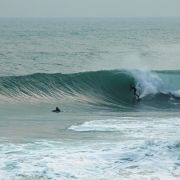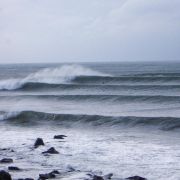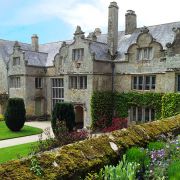As Cornwall's biggest and brashest holiday resort Newquay will not disappoint. Heaving from the first day of summer this is every bit the classic British seaside town, but with a few twists.
To me Newquay feels like a different place to the rest of Cornwall, it almost has the air of a resort on the Costa (except without the guaranteed sunshine!). You'll find the bucket and spade brigade rubbing shoulders with a younger set, determined to party as hard as is humanly possible. Stag and hen groups terrorise the pubs and clubs whilst coach loads of pensioners spend the days reliving the good old days. There is nothing overly sophisticated about Newquay, but that is part of its popularity.
Regardless of what people may think or say about Newquay it is still the most popular resort town in Cornwall by a long way, and that speaks volumes. There is something for everyone here; family-friendly beaches, raucous nightlife, great surf and even some top-notch restaurants. So without further ado, here are our suggestions for what to do in Newquay.
Beaches and more beaches...
It isn't really a coincidence that Newquay is where it is. The whole of Cornwall's north coast is home to some of the most spectacular sandy beaches, but nowhere is there a greater concentration than around Newquay. To the west is Perranporth, and to the east Padstow; both are known for great beaches with many of the best lying somewhere in between. These are iconic Cornish beaches with miles of golden sand facing into the deep blue waters of the Atlantic Ocean and interspersed with rugged coastline.
Newquay itself is home to around 7 miles of sandy beaches and at low tide a vast expanse of unbroken golden sand is revealed directly in front of the town. Stretching from Towan beach all the way to Porth, these become separate coves as the tide comes in with each beach having its own character.
Just around Towan Headland is Newquay's biggest and best-known beach, Fistral. A wide stretch of beautiful golden sand the beach here faces into the full force of the Atlantic making it one of the best surfing beaches in Cornwall. Whilst the waves here can get pretty big so can the crowds.
Surfing
Known as the UK's surf city, Newquay has a surf heritage going back to the 1960s. It was traveling Ozzies who spotted the potential of Fistral beach as a world class surf spot and since then the town's identity has become defined by surfing.
Back in the 1980s the Surfmasters competition was a regular stop on the surfing pro tour. All the big names surfed here but the contest tended to be held in August when the waves were at their least consistent. Over the years the surf part of the "masters" faded whilst the festival side became huge, morphing into the the Boardmasters.
As a rule Fistral Beach lives up its reputation as one of the best surf spots in Cornwall. It has consistent waves, can be good when it gets bigger and the level of surfing is high. It is also home to the UK's premiere big wave spot - The Cribbar. Only breaking a few times every year, the wave off Towan Headland can be surfed at over 25ft.
For the rest of us there are any number of surf schools at Fistral and neighbouring beaches such as Watergate Bay, Crantock and Holywell Bay. These beaches provide a great, less crowded option all under the watchful eye of the seasonal lifeguard service.
Blue Reef Aquarium
The Blue Reef Aquarium has an enviable location right on the seafront at Towan Beach. This is a wonderful place to kill a few hours on a rainy afternoon, or otherwise, and there is enough to see here to keep all but the most awkward teenagers occupied.
There are a number of displays encompassing a range of ocean environments at the aquarium. Several cover the local Cornish coast where you can catch up with what you might have missed in the local rock-pools. The centrepiece though, is the tropical coral reef set within a 250,000 litre tank. Here you can see exotic species including reef fish, stingrays, and even a few sharks. The tank is also home to Omiros, a blind Loggerhead turtle rescued over 10 years ago. Viewing is an immersive experience with a glass tunnel snaking its way through the main tank.
Other favourites include seahorses, pulsating jellyfish, poisonous stonefish, giant octopus and razor-toothed piranhas. Along with regular feeding displays, rock-pooling workshops and educational talks this all adds up to a fascinating day out.
Fishing Heritage
It's hard to imagine now, but once-upon-a-time Newquay was a small fishing village and there were no tourists. Back in the 15th century the main industry in town was pichards and fishing was still a big part of life right up until the railway arrived in the late 1800s.
The name Newquay actually refers to a new harbour wall (quay) that was built during the heyday of the pichard boom. Up until the mid 1400s the town was known as "Towan Blystra", although no one is sure what this translates to, except Wetherspoons who used it for the name of their Newquay pub!
For those looking for a bit of historic Newquay there are a few reminders dotted around the town. The most obvious of these is the sturdy harbour, tucked away to the east of Towan Headland. This continued to expand even after fishing peaked with the mining industry taking over. Tin and copper ore from the local mines was shipped over to South Wales where they were smelted. At one point there was a tramway carrying the ore down to the harbour via a tunnel. The mouth of the tunnel is still here and is currently used to store the boats of the local gig rowing club.
Still retaining much of its charm the harbour is now overlooked by guesthouses and apartments. It is a great place to while away an hour, taking in the view back to the beach and watching the few remaining fishermen at work.
Another of Newquay's historical highlights is the Huer's Hut between Fistral beach and the harbour. This curious little white building dates back to the 14th century when it was occupied by the huer, one of the most important jobs in town. He would use this lookout to spot the pilchard shoals that the town depended on and when sighted would let for the cry of "Hevva, hevva!". Once the fishing fleet was in position the huer would use his vantage point to guide the boats towards the fish.
Partying
As long as I can remember Newquay has been the home to the liveliest nightlife in Cornwall... by a long way. In the summer the party scene in the town can rival anywhere in Europe. Think Magaluf on a budget and without a passport and you're halfway there!
Whether or not it is anything to boast about, Newquay is without doubt the premiere stag and hen night destination in the UK. And why wouldn't it be? As we've already mentioned there are world-class beaches here. Add to this whole range of accommodation, from luxury right down to the notorious budget backpackers, and what more could you ask for?
Ah, yes, drinking and dancing. As Cornwall's very own answer to Ibiza (!) you won't have any problem finding a seafront bar, or cosy pub to start the evening off. For sounds there are plenty of old favourites such as Berties and Sailors along with a few newer, classier spots.
It isn't just pubs and clubs though. The biggest gig in town is the Boardmasters Festival - five days of big name bands and extreme sports right on the beach in the middle of August.
And whatever you might read in the media about how Newquay is moving upmarket and away from its boisterous reputation - don't believe a word. For better or for worse, love it or hate it, Newquay is still the same old Newquay!
Newquay Zoo
Owned by the same people as the hugely popular Paignton Zoo, Newquay's punches well above its weight for a relatively small zoo. Tucked away behind Trenance Gardens the zoo is home to over 130 species of animals ranging from the usual favourites through to some quite rare and bizarre creatures.
Dating all the way back to the 1960s, Newquay Zoo started out as not much more than a little pet's corner. Things have moved on somewhat since then and today the zoo rivals many of the best in the country.
The site is arranged into various enclosures and areas with many of the most exciting animals residing in the Tropical House, African Savannah or the lakeside gardens. These are various amphibians, primates, and some pretty impressive bigger beasts such as lions and wildebeest. A large part of the zoo's work involves education and conservation with a number of breeding programs for endangered species.
As with many wildlife attractions there are plenty of hands on opportunities such as feeding the Humboldt penguins and meerkats. There are also a fair few activities that will appeal to all ages including the Dragon Maze, play parks and a cafe.
Walk to Crantock
You can walk either way along the coast from Newquay and you will most certainly not be disappointed. However, I chose this way (west) because it offers an almost immediate change of scenery and plenty of interest en-route.
After leaving the town centre the coast path really begins just beyond the harbour. It doesn't take long before you are out on the cliffs as you pass the diminutive white-washed Huer's Hut. From here you can cut across to Fistral beach or head right out to Towan Headland which offers spectacular views along the coast in both directions.
After a stroll across the dunes of Fistral there is another headland to round - Pentire Head. This is one of Newquay's most ancient places and has signs of human habitation dating back to the Stone Age, 8 thousand years ago. From the end of this narrow peninsula you can look back towards Fistral and over the vast sands of Crantock beach.
This is an incredibly rugged and dramatic place, particularly when there is a storm blowing. However, tucked away, in the shelter of Pentire Head is the River Gannel. This tidal estuary is quite a fascinating place, and at low tide the sands stretch over a mile inland and the river forms shallow pools of warm water. At this state of tide you can easily cross the river at a couple of points where there are stepping stones. As the tide comes in you will need to catch the little ferry back, or it is a long walk round. Great news if you are a twitcher as there are all manner of wading birds to be seen upstream.
The beach at Crantock is something of a gem. It can rival neighbouring Fistral in terms of size and surf, but you won't have to contend with anything like the crowds. If you enjoyed walking round to Crantock then carry on as the scenery only gets better, with two more stunning beaches before you reach the majestic sands of Perranporth.
Lappa Valley
Lappa Valley is located a few miles outside newquay in Newlyn East. I have to admit I'm a little biased about this place, as I imagine anyone who grew up in the 70s and 80s would be. This is a classic family day out which is both pure nostalgia, but also perfect for younger kids. You won't find high adrenaline action at Lappa Valley but you will be transported back to a time when things were just that bit simpler.
Set in a pretty valley, teeming with wildlife, much of the attraction is based around three narrow-gauge railways. The largest of these is based on the original Treffry tramway, with mini-locomotives Zebedee and Muffin taking visitors from the car park end station of Benny's Halt, through the woods to the main leisure park. Here you will find not only more railways, but a host of wholesome activities including crazy golf, play areas, boating lake and nature trails. There's also a cafe and plenty of areas for picnics.
Overlooking the site is the particularly impressive engine house of the East Wheal Rose mine. Back in the 1840s over 1,200 men, women and children worked here - a far cry from today's fun-filled activities. Tragically though, the mine was also the scene of Cornwall's worst mining disaster.
Trerice
Just a stone's throw from Lappa Valley is the petite Elizabethan manor house of Trerice. Despite being barely outside of Newquay it feels a million miles away with the Atlantic coast swapped for a backdrop of rolling countryside. The National Trust have owned the property since 1953 but the house dates back to 1573 when it was built for John Arundell, the High Sheriff, whose family were one of the most influential in medieval Cornwall.
What is particularly interesting about Trerice is how original it is, having escaped the modifications inflicted on many historic houses during the 18th and 19th century. The house is built to the classic Tudor E-shape plan set within formal gardens that quickly give way to woods and farmland beyond. Inside is an extensive collection of over a thousand pieces of art and furniture, but it is the Great Hall, with its huge window, which is Trerice's most impressive feature. In its day this giant mullion window would have been quite a statement with its 576 separate tiles of glass.
In keeping with the house, the gardens feature an Elizabethan style turf maze, apple orchard and kitchen garden. There are also some outdoor games from the period; Cornish Kayles, a type of skittles and Slapcock( tudor Badminton) both of which you can try whatever your age. You will also find a collection of historic lawnmowers tucked away in a barn, if that sort of thing interests you.
The spacious old barn, which sits behind the house has now been converted into a cafe and serves food incorporating ingredients grown in the gardens (amongst other things).
Japanese Garden
The Japanese Garden all started back in the 1990s with a single bonsai tree. Since then the garden has grown to fill the one acre site with traditionally Japanese inspired features.
Whilst not being 100% orthodox in it's design, the garden itself is pretty authentic in style and has met with the approval of Japanese visitors over the years. It contains many of the features associated with a Japanese garden including the shishi-odoshi (deer scarer), stone lanterns, tsukubai (water basin), bonsai and of course, the waterfalls, ponds, bridges, islands and teahouse. There is also a traditional Zen garden of tranquility where there are no plants just meticulously positioned rocks and sand which is raked everyday.
The selection of plants includes species which flourish in Newquay's sub-tropical climate, and include azaleas, rhododendrons, bamboos, and of course, Japanese Maples. Interspersed with various moss-covered granite boulders and a koi carp pond, this is a wonderfully relaxing spot to while away an hour or two.















